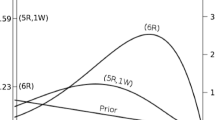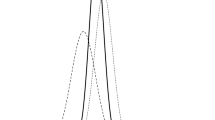Abstract
In the first instalment of this series, Stang and Poole provided an overview of Fisher significance testing (ST), Neyman–Pearson null hypothesis testing (NHT), and their unfortunate and unintended offspring, null hypothesis significance testing. In addition to elucidating the distinction between the first two and the evolution of the third, the authors alluded to alternative models of statistical inference; namely, Bayesian statistics. Bayesian inference has experienced a revival in recent decades, with many researchers advocating for its use as both a complement and an alternative to NHT and ST. This article will continue in the direction of the first instalment, providing practicing researchers with an introduction to Bayesian inference. Our work will draw on the examples and discussion of the previous dialogue.



Similar content being viewed by others
References
Stang A, Poole C. The researcher and the consultant: a dialogue on null hypothesis significance testing. Eur J Epidemiol. 2013;28(12):939–44.
Greenland S. Bayesian perspectives for epidemiological research: I. Foundations and basic methods. Int J Epidemiol. 2006;35(3):765–75.
Goodman SN. Introduction to Bayesian methods I: measuring the strength of evidence. Clin Trials. 2005;2(4):282–290; discussion 301–284, 364–278.
Goodman SN. Toward evidence-based medical statistics. 2: the Bayes factor. Ann Intern Med. 1999;130(12):1005–13.
MacLehose R, Hamra G. Applications of Bayesian methods to epidemiologic research. Curr Epidemiol Rep. 2014;1(3):103–9.
Rothman KJ, Greenland S, Lash TL. Modern epidemiology. 3rd ed. Philadelphia: Wolters Kluwer Health/Lippincott Williams & Wilkins; 2008.
MacLehose RF, Hamra GB. Applications of Bayesian methods to epidemiologic research. Curr Epidemiol Rep. 2014;1:103–9.
Greenland S. Principles of multilevel modelling. Int J Epidemiol. 2000;29(1):158–67.
Hamra GB, MacLehose RF, Cole SR. Sensitivity analyses for sparse-data problems—using weakly informative Bayesian priors. Epidemiology. 2013;24(2):233–9.
Greenland S. Modeling and variable selection in epidemiologic analysis. Am J Public Health. 1989;79(3):340–9.
Greenland S. Invited commentary: variable selection versus shrinkage in the control of multiple confounders. Am J Epidemiol. 2008;167(5):523–9.
Greenland S. Bayesian perspectives for epidemiological research II. Regression analysis. Int J Epidemiol. 2007;36(1):195–202.
Lash TL, Fox MP, Fink AK. Applying quantitative bias analysis to epidemiologic data. Dordrecht; New York: Springer; 2009.
Steenland K, Greenland S. Monte Carlo sensitivity analysis and Bayesian analysis of smoking as an unmeasured confounder in a study of silica and lung cancer. Am J Epidemiol. 2004;160(4):384–92.
Greenland S. Bayesian perspectives for epidemiologic research. III. Bias analysis via missing-data methods (vol 38, p. 1662, 2009). Int J Epidemiol. 2010;39(4):1116.
Hamra G, Richardson D, Maclehose R, Wing S. Integrating informative priors from experimental research with Bayesian methods: an example from radiation epidemiology. Epidemiology. 2013;24(1):90–5.
Chu H, Cole SR. Estimation of risk ratios in cohort studies with common outcomes: a Bayesian approach. Epidemiology. 2010;21(6):855–62.
Cole SR, Chu HT, Greenland S, Hamra G, Richardson DB. Bayesian posterior distributions without Markov chains. Am J Epidemiol. 2012;175(5):368–75.
Sullivan SG, Greenland S. Bayesian regression in SAS software. Int J Epidemiol. 2013;42(1):308–17.
Sullivan SG, Greenland S. Bayesian regression in SAS software. Int J Epidemiol. 2014;43(3):974.
Conflict of interest
None.
Author information
Authors and Affiliations
Corresponding author
Electronic supplementary material
Below is the link to the electronic supplementary material.
Rights and permissions
About this article
Cite this article
Hamra, G.B., Stang, A. & Poole, C. The researcher and the consultant: from testing to probability statements. Eur J Epidemiol 30, 1003–1008 (2015). https://doi.org/10.1007/s10654-015-0054-1
Received:
Accepted:
Published:
Issue Date:
DOI: https://doi.org/10.1007/s10654-015-0054-1




